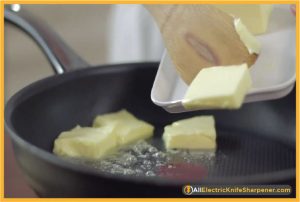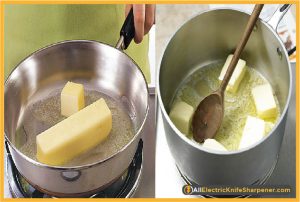Melting butter is an essential cooking tool for preparing various delicious dishes.The process of melting butter helps to create a flavorful base that allows other ingredients and flavours to blend.
It also enables the creation of sauces and soups that have a rich taste and can store in the refrigerator for later use.
Moreover, melted butter can add just the right amount of moisture to baked goods, providing moistness and texture that enhance any concoction.
And last but not least, adding melted butter on top of finished dishes such as grilled lobster or raw oysters adds texture and flavour that genuinely elevates any meal.
Chefs must know the proper technique for melting butter to a silky smooth consistency. Butter can be melted in a saucepan over low heat until it’s completely liquid or microwaved for quicker results.
Once the butter has completely melted, any remaining foam should be skimmed off and discarded.
Careful attention must be taken when monitoring and stirring the butter while it melts – too much heat or over-stirring will cause it to burn or lose flavour.
With practice and patience, professional chefs develop a keen eye and pallet that help them craft delicious recipes incorporating perfectly melted butter.
Read More about How to melt butter in a microwave and on the stove.

Table of contents
How to Melt Butter In The Microwave

Melting butter in the microwave can be an absolute lifesaver! Whether baking, sautéing, or making a sauce, having melted butter on hand makes your cooking experience much smoother.
But if this is your first time melting butter in the microwave and you feel overwhelmed, never fear! We’ve outlined just how easy it is to melt butter quickly and safely so that you always have some ready for when inspiration strikes.
So put down those stovetop pans—at least you won’t need them for this task!You can melt solid butter quickly in the microwave by following these steps:
Cut
Cut the butter into small cubes or slices,
Cover And Place It In The Oven
Cover the butter with a paper towel. Put in a microwave-safe bowl.
Heat
Microwave should be high for 30 seconds to 1 minute, depending on the wattage of your microwave and how much butter you’re using.
Stir
Stir the melted butter with a spoon to ensure it’s even throughout.
How to Melt Butter On The Stovetop

Melting butter on the stovetop is a technique every good cook should know. It’s great for creating sauces, sautéing vegetables, and baking recipes that call for melted butter.
Plus, it’s really easy to do! All you need is a saucepan or skillet and your trusty wooden spoon or silicon spatula. Let’s get started!
Cut
Cut Slice the stick of butter into small pieces.
Heat
Melt solid butter slowly over medium-low heat in a saucepan or skillet. Note: You want the temperature to be manageable, which can cause the butter to burn quickly.
Stir
Stir until it’s completely melted, about 5 minutes or so. Use immediately or store in an airtight container in the refrigerator for future use.
By following these simple steps, you’ll be able to master the art of melting butter in no time! Not only is it a great skill to have in your cooking arsenal, but with practice and patience, you can create delicious recipes incorporating perfectly melted butter. Enjoy!
Best Ways To Use Melted Butter

Now that you know how to melt butter on the stovetop or in the microwave, it’s time to put your new skill to good use! The possibilities are endless when it comes to using melted butter. Here are just a few of our favourite ways:
Baking
Not only does melted butter gives baked goods a golden brown finish, but its rich flavour can enhance sweet treats like muffins and cakes.
Sautéing
Melted butter adds moisture and flavour when sautéing vegetables or proteins.
Sauces and Soups
A pat of melted butter can add richness and creaminess to sauces like cheese sauce or tomato sauce, as well as soups like cream of broccoli or mushroom.
Topping
Drizzle some melted butter over popcorn, toast, pancakes, or waffles for a delicious finishing touch.
Once you get the hang of melting butter in the microwave and stovetop, you’ll find many more uses! So experiment with different recipes and enjoy your perfectly melted butter. Bon Appétit!
How To Use Melt Butter As Cooking Oil

You can use melted butter as cooking oil for roasting, pan-frying, or sautéing meats and vegetables. The flavour and texture of melted butter add a unique richness to food that no other oil can.
You can also use melted butter as a finishing oil for grilled or roasted vegetables, seafood, and poultry. Add one tablespoon of melted butter to 2 tablespoons of cooking oil to make your finishing oil with melted butter.
Heat in a pan until the butter is fully incorporated into the mixture, and you’re ready to go! When working with cooking oils, always remember to be mindful of your safety while handling hot liquids.
Be sure to use mitts when taking anything hot, keep a close eye on what’s happening in the kitchen, and never leave flammable items near open flames. Safety first!
Such as olive oil or vegetable oil can also be used in place of melted butter for sautéing and baking.
But remember: when it comes to flavour, only melted butter will do! So fire up your stovetop or microwave and fantastic craft recipes with perfectly melted butter. Bon Appétit!
You Might be interested to Read About:How To Cut Potatoes For French Fries